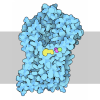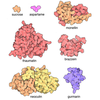+ Open data
Open data
- Basic information
Basic information
| Entry | Database: PDB / ID: 8yt8 | ||||||
|---|---|---|---|---|---|---|---|
| Title | Cryo-EM structure of the dystrophin glycoprotein complex | ||||||
 Components Components |
| ||||||
 Keywords Keywords | STRUCTURAL PROTEIN / complex membrane stability signaling | ||||||
| Function / homology |  Function and homology information Function and homology informationdystrobrevin complex / olfactory nerve structural organization / sarcoglycan complex / coronary vasculature morphogenesis / O-linked glycosylation / establishment of blood-nerve barrier / striated muscle cell development / establishment of glial blood-brain barrier / dystroglycan complex / nerve maturation ...dystrobrevin complex / olfactory nerve structural organization / sarcoglycan complex / coronary vasculature morphogenesis / O-linked glycosylation / establishment of blood-nerve barrier / striated muscle cell development / establishment of glial blood-brain barrier / dystroglycan complex / nerve maturation / retrograde trans-synaptic signaling by trans-synaptic protein complex / walking behavior / connective tissue development / regulation of cellular response to growth factor stimulus / reactive oxygen species biosynthetic process / Regulation of expression of SLITs and ROBOs / contractile ring / cardiac muscle cell action potential / calcium-dependent cell-matrix adhesion / nucleus localization / morphogenesis of an epithelial sheet / regulation of skeletal muscle contraction / glucose import in response to insulin stimulus / microtubule anchoring / vascular associated smooth muscle cell development / dystrophin-associated glycoprotein complex / laminin-1 binding / response to denervation involved in regulation of muscle adaptation / matrix side of mitochondrial inner membrane / neurofilament / Formation of the dystrophin-glycoprotein complex (DGC) / cell-substrate junction / myotube cell development / Striated Muscle Contraction / postsynaptic specialization / photoreceptor ribbon synapse / basement membrane organization / dystroglycan binding / heart process / regulation of skeletal muscle contraction by regulation of release of sequestered calcium ion / lamin binding / positive regulation of myelination / cellular response to cholesterol / vinculin binding / regulation of sodium ion transmembrane transport / branching involved in salivary gland morphogenesis / skeletal muscle tissue regeneration / costamere / commissural neuron axon guidance / myelination in peripheral nervous system / membrane organization / muscle cell development / protein-containing complex localization / regulation of calcium ion transmembrane transport / neuron projection terminus / node of Ranvier / cardiac muscle cell contraction / angiogenesis involved in wound healing / synaptic transmission, cholinergic / limb development / cardiac muscle cell development / axon regeneration / structural constituent of muscle / positive regulation of cell-matrix adhesion / astrocyte projection / muscle organ development / muscle cell cellular homeostasis / negative regulation of neuron differentiation / response to muscle activity / regulation of synapse organization / epithelial tube branching involved in lung morphogenesis / nitric-oxide synthase binding / regulation of neurotransmitter receptor localization to postsynaptic specialization membrane / alpha-actinin binding / membrane protein ectodomain proteolysis / positive regulation of oligodendrocyte differentiation / basement membrane / plasma membrane raft / response to glucose / postsynaptic cytosol / regulation of cardiac muscle contraction by regulation of the release of sequestered calcium ion / Schwann cell development / striated muscle contraction / heart morphogenesis / skeletal muscle tissue development / calcium ion homeostasis / laminin binding / cardiac muscle contraction / negative regulation of MAPK cascade / regulation of release of sequestered calcium ion into cytosol by sarcoplasmic reticulum / neuron projection morphogenesis / response to muscle stretch / positive regulation of neuron differentiation / negative regulation of phosphatidylinositol 3-kinase/protein kinase B signal transduction / tubulin binding / SH2 domain binding / regulation of heart rate / nuclear periphery / secretory granule / negative regulation of cell migration Similarity search - Function | ||||||
| Biological species |  | ||||||
| Method | ELECTRON MICROSCOPY / single particle reconstruction / Resolution: 3.5 Å | ||||||
 Authors Authors | Wu, J.P. / Yan, Z. / Wan, L. | ||||||
| Funding support |  China, 1items China, 1items
| ||||||
 Citation Citation |  Journal: Nature / Year: 2025 Journal: Nature / Year: 2025Title: Structure and assembly of the dystrophin glycoprotein complex. Authors: Li Wan / Xiaofei Ge / Qikui Xu / Gaoxingyu Huang / Tiandi Yang / Kevin P Campbell / Zhen Yan / Jianping Wu /   Abstract: The dystrophin glycoprotein complex (DGC) has a crucial role in maintaining cell membrane stability and integrity by connecting the intracellular cytoskeleton with the surrounding extracellular ...The dystrophin glycoprotein complex (DGC) has a crucial role in maintaining cell membrane stability and integrity by connecting the intracellular cytoskeleton with the surrounding extracellular matrix. Dysfunction of dystrophin and its associated proteins results in muscular dystrophy, a disorder characterized by progressive muscle weakness and degeneration. Despite the important roles of the DGC in physiology and pathology, its structural details remain largely unknown, hindering a comprehensive understanding of its assembly and function. Here we isolated the native DGC from mouse skeletal muscle and obtained its high-resolution structure. Our findings unveil a markedly divergent structure from the previous model of DGC assembly. Specifically, on the extracellular side, β-, γ- and δ-sarcoglycans co-fold to form a specialized, extracellular tower-like structure, which has a central role in complex assembly by providing binding sites for α-sarcoglycan and dystroglycan. In the transmembrane region, sarcoglycans and sarcospan flank and stabilize the single transmembrane helix of dystroglycan, rather than forming a subcomplex as previously proposed. On the intracellular side, sarcoglycans and dystroglycan engage in assembly with the dystrophin-dystrobrevin subcomplex through extensive interaction with the ZZ domain of dystrophin. Collectively, these findings enhance our understanding of the structural linkage across the cell membrane and provide a foundation for the molecular interpretation of many muscular dystrophy-related mutations. | ||||||
| History |
|
- Structure visualization
Structure visualization
| Structure viewer | Molecule:  Molmil Molmil Jmol/JSmol Jmol/JSmol |
|---|
- Downloads & links
Downloads & links
- Download
Download
| PDBx/mmCIF format |  8yt8.cif.gz 8yt8.cif.gz | 433.5 KB | Display |  PDBx/mmCIF format PDBx/mmCIF format |
|---|---|---|---|---|
| PDB format |  pdb8yt8.ent.gz pdb8yt8.ent.gz | Display |  PDB format PDB format | |
| PDBx/mmJSON format |  8yt8.json.gz 8yt8.json.gz | Tree view |  PDBx/mmJSON format PDBx/mmJSON format | |
| Others |  Other downloads Other downloads |
-Validation report
| Summary document |  8yt8_validation.pdf.gz 8yt8_validation.pdf.gz | 1010.1 KB | Display |  wwPDB validaton report wwPDB validaton report |
|---|---|---|---|---|
| Full document |  8yt8_full_validation.pdf.gz 8yt8_full_validation.pdf.gz | 1 MB | Display | |
| Data in XML |  8yt8_validation.xml.gz 8yt8_validation.xml.gz | 44.2 KB | Display | |
| Data in CIF |  8yt8_validation.cif.gz 8yt8_validation.cif.gz | 65.6 KB | Display | |
| Arichive directory |  https://data.pdbj.org/pub/pdb/validation_reports/yt/8yt8 https://data.pdbj.org/pub/pdb/validation_reports/yt/8yt8 ftp://data.pdbj.org/pub/pdb/validation_reports/yt/8yt8 ftp://data.pdbj.org/pub/pdb/validation_reports/yt/8yt8 | HTTPS FTP |
-Related structure data
| Related structure data |  39568MC C: citing same article ( M: map data used to model this data |
|---|---|
| Similar structure data | Similarity search - Function & homology  F&H Search F&H Search |
- Links
Links
- Assembly
Assembly
| Deposited unit | 
|
|---|---|
| 1 |
|
- Components
Components
-Protein , 8 types, 8 molecules ABCDEGOS
| #1: Protein | Mass: 32539.186 Da / Num. of mol.: 1 / Source method: isolated from a natural source / Source: (natural)  |
|---|---|
| #2: Protein | Mass: 28729.967 Da / Num. of mol.: 1 / Source method: isolated from a natural source / Source: (natural)  |
| #3: Protein | Mass: 23363.234 Da / Num. of mol.: 1 / Source method: isolated from a natural source / Source: (natural)  |
| #4: Protein | Mass: 29191.100 Da / Num. of mol.: 1 / Source method: isolated from a natural source / Source: (natural)  |
| #5: Protein | Mass: 38371.391 Da / Num. of mol.: 1 / Source method: isolated from a natural source / Source: (natural)  |
| #6: Protein | Mass: 28956.158 Da / Num. of mol.: 1 / Source method: isolated from a natural source / Source: (natural)  |
| #8: Protein | Mass: 31934.459 Da / Num. of mol.: 1 / Source method: isolated from a natural source / Source: (natural)  |
| #9: Protein | Mass: 19917.953 Da / Num. of mol.: 1 / Source method: isolated from a natural source / Source: (natural)  |
-Protein/peptide , 1 types, 1 molecules I
| #7: Protein/peptide | Mass: 559.741 Da / Num. of mol.: 1 / Source method: isolated from a natural source / Details: unassigned / Source: (natural)  |
|---|
-Sugars , 5 types, 12 molecules 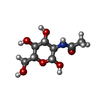
| #10: Polysaccharide | beta-D-mannopyranose-(1-4)-2-acetamido-2-deoxy-beta-D-glucopyranose-(1-4)-2-acetamido-2-deoxy-beta- ...beta-D-mannopyranose-(1-4)-2-acetamido-2-deoxy-beta-D-glucopyranose-(1-4)-2-acetamido-2-deoxy-beta-D-glucopyranose Source method: isolated from a genetically manipulated source #11: Polysaccharide | beta-D-mannopyranose-(1-3)-2-acetamido-2-deoxy-beta-D-glucopyranose-(1-3)-2-acetamido-2-deoxy-beta- ...beta-D-mannopyranose-(1-3)-2-acetamido-2-deoxy-beta-D-glucopyranose-(1-3)-2-acetamido-2-deoxy-beta-D-glucopyranose | Type: oligosaccharide / Mass: 586.542 Da / Num. of mol.: 1 Source method: isolated from a genetically manipulated source #12: Polysaccharide | Source method: isolated from a genetically manipulated source #13: Polysaccharide | beta-D-mannopyranose-(1-3)-2-acetamido-2-deoxy-beta-D-glucopyranose-(1-4)-2-acetamido-2-deoxy-beta- ...beta-D-mannopyranose-(1-3)-2-acetamido-2-deoxy-beta-D-glucopyranose-(1-4)-2-acetamido-2-deoxy-beta-D-glucopyranose | Source method: isolated from a genetically manipulated source #14: Sugar | |
|---|
-Non-polymers , 4 types, 6 molecules 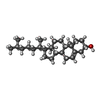

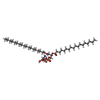




| #15: Chemical | | #16: Chemical | ChemComp-ZN / | #17: Chemical | ChemComp-P5S / | #18: Chemical | ChemComp-CA / | |
|---|
-Details
| Has ligand of interest | Y |
|---|---|
| Has protein modification | Y |
-Experimental details
-Experiment
| Experiment | Method: ELECTRON MICROSCOPY |
|---|---|
| EM experiment | Aggregation state: PARTICLE / 3D reconstruction method: single particle reconstruction |
- Sample preparation
Sample preparation
| Component | Name: dystrophin glycoprotein complex, DGC / Type: COMPLEX / Entity ID: #1-#9 / Source: NATURAL |
|---|---|
| Molecular weight | Experimental value: NO |
| Source (natural) | Organism:  |
| Buffer solution | pH: 7.4 / Details: 25 mM MOPS-Na, 150 mM NaCl, 2 mM CaCl2, 0.01% GDN |
| Specimen | Embedding applied: NO / Shadowing applied: NO / Staining applied: NO / Vitrification applied: NO |
- Electron microscopy imaging
Electron microscopy imaging
| Experimental equipment |  Model: Titan Krios / Image courtesy: FEI Company |
|---|---|
| Microscopy | Model: FEI TITAN KRIOS |
| Electron gun | Electron source:  FIELD EMISSION GUN / Accelerating voltage: 300 kV / Illumination mode: FLOOD BEAM FIELD EMISSION GUN / Accelerating voltage: 300 kV / Illumination mode: FLOOD BEAM |
| Electron lens | Mode: BRIGHT FIELD / Nominal defocus max: 1900 nm / Nominal defocus min: 1400 nm |
| Image recording | Electron dose: 50 e/Å2 / Film or detector model: GATAN K3 BIOQUANTUM (6k x 4k) |
- Processing
Processing
| CTF correction | Type: NONE | ||||||||||||||||||||||||
|---|---|---|---|---|---|---|---|---|---|---|---|---|---|---|---|---|---|---|---|---|---|---|---|---|---|
| 3D reconstruction | Resolution: 3.5 Å / Resolution method: FSC 0.143 CUT-OFF / Num. of particles: 499658 / Symmetry type: POINT | ||||||||||||||||||||||||
| Atomic model building | Protocol: FLEXIBLE FIT | ||||||||||||||||||||||||
| Refine LS restraints |
|
 Movie
Movie Controller
Controller




 PDBj
PDBj





